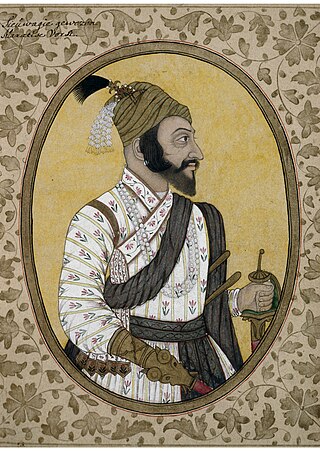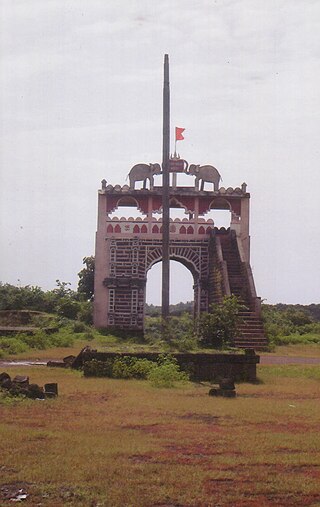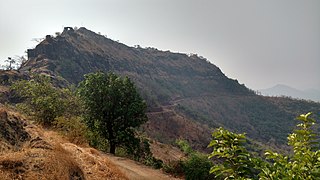
Shivaji I was an Indian ruler and a member of the Bhonsle dynasty. Shivaji carved out his own independent kingdom from the Sultanate of Bijapur that formed the genesis of the Maratha Confederacy. In 1674, he was formally crowned the Chhatrapati of his realm at Raigad Fort.

Kolhapur is a city on the banks of the Panchganga River in the southern part of the Indian state of Maharashtra.

Panhala is a city and a Hill station Municipal Council 18 km northwest of Kolhapur, in Kolhapur district in the Indian state of Maharashtra. Panhala is the smallest city in Maharashtra and being a Municipal Council the city is developing rapidly. The city sprawls in the Panhala fort commands a panoramic view of the valley below. The main historical attraction here is the Panhala fort. There are many places of interest, each with its share of haunting anecdotes.

Baji Prabhu Deshpande was a general of the Maratha Army. He is known for his role in the Battle of Pavan Khind at Ghod Khind, where he sacrificed his life defending Shivaji Maharaj from incoming Adil Shahi forces of Siddi Johar. He also was a landlord or Vatandar in the Maval region.

Chiplun ( [t͡ʃipɭuːɳ]) is a city in Ratnagiri district in the state of Maharashtra, India. It is one of the financial and commercial hubs of Ratnagiri district, and the headquarters of Chiplun taluka. It is about 250 km south of Mumbai and 90 km North of Ratnagiri in the Konkan region of Maharashtra, on the Mumbai–Goa highway (NH-66). It has a long history and a strong cultural background. Recent decades have seen much industrial development in it and its and surrounding areas.
Murud is a town and a municipal council in Raigad district in the Indian state of Maharashtra. Situated at a distance of 150 km (93 mi) from Mumbai, Murud is a tourist destination. The Palace of Nawab is located in Murud. The palace was built in 1885 for administration purposes. The palace is still owned by the descendants of the Nawab and is a private property.
Sangole or (Sangola) is a city with a municipal council in Solapur district in the Indian state of Maharashtra. It is situated near Holy city Pandharpur. It is located at the intersection of state highways SH-161, SH-3, and SH-71.
Shirur is an administrative subdivision of the Pune district in the Indian state of Maharashtra. It is located on the eastern boundary of the district, on the banks of the Ghod River. The town is also called Ghodnadi to distinguish it from other locations that have the same name. Ghodnadi in Marathi Language means Ghod River.
Prachitgad is a fort in the Sahyadri mountain range in Sangli district of Maharashtra state, India. It covers an area of 5 acres (20,000 m2).

Panhala fort, is located in Panhala, 20 kilometres northwest of Kolhapur in Maharashtra, India. It is strategically located looking over a pass in the Sahyadri mountain range which was a major trade route from Bijapur in the interior of Maharashtra to the coastal areas. Due to its strategic location, it was the centre of several skirmishes in the Deccan involving the Marathas, the Mughals and the British the grand son's of chhatrapati shivaji maharaj East India Company, the most notable being the Battle of Pavan Khind. Here, the queen regent of Kolhapur, Tarabai Ranisaheb, spent her formative years. Several parts of the fort and the structures within are still intact. It is also called as the 'Fort of Snakes' as it is zigzagged in shape.

Vijaydurg, the oldest fort on the Sindhudurg coast, was constructed during the regime of Raja Bhoja II of the Shilahar dynasty and restructured by Shivaji.
Devrukh is a town in the tehsil of Sangameshwar in the Ratnagiri district of the Indian state of Maharashtra. It is headquarters for the Sangameshwar tehsil and a part of the Konkan region. The town enjoys salubrious climate, and the majority population is involved in agriculture. Summers are warm and winters are not very chilly. Every year Devrukh experiences heavy monsoon. Rice, cashew and alphonso (hapus) mangoes are the major crops in Devrukh.

Vatul is a village in the State of Maharashtra in India with a population 1349-Male-657-Females-692. 339 houses are in Vatul village. Child population - 124-Male-64-Female-60. Schedule Caste - 91-Male-45-Female-46. Schedule Tribe - 3-Male-2-Female-1. Literacy - 85.39%-Male-94.60%-Female-76.74%. The closest tourism destination to Vatul is Ratnagiri. Other close by tourism destinations include Panhala, Dajipur and Kunkeshwar. The nearest major railway station to Vatul is Ratnagiri (RN) which is at a distance of 23.3 kilometres. The nearest airport is at Goa which is at a distance of 154 kilometres.

Rameshwar also known as Rameshwar Wadi is a small town located on the coast of Sindhudurg District of Maharashtra on the west coast of India. A very old Shri Dev Rameshwar Temple is located in this town which is dedicated to the Hindu deity Shiva.
Rajapur taluka is a taluka in Ratnagiri district of Maharashtra an Indian state. The temple of Aryadurga devi is located in the Devihasol village in Rajapur taluka.

Rasalgad is a fort in the Maharashtra state of India. It lies 15 km east of Khed City. The fort has been developed as a tourist attraction. Its fortification is in good condition. The fort lied on the south end of a narrow spur which joins with Suamargad and Mahipatgad in the north direction. In 2003 the fort was declared a protected monument by the Archaeological Survey of India.

Aryadurga devi, Devihasol आर्यादुर्गा देवी देवीहसोळ, is a Hindu temple situated in Devihasol village in Rajapur taluka, Maharashtra, India. It is 18 km (11 mi) from Rajapur, 52 km (32 mi) from Ratnagiri and 380 km (240 mi) from Mumbai. Many devotees come to visit this temple. The fair of Aryadurga devi and Navadurga devi (bhalavli) is also famous, occurring annually in October on the eighth day of the Hindu Navratri festival. Goddess Aryadurga is the Kuldevi of many Karahde Brahmin. Several other temples, including in the towns of Mahakali, Adivare, Marleshwar, and Ganpatipule are located nearby.

Ratnagiri Fort, also called Ratnadurg Fort or Bhagawati Fort, is a fort located 2 km from Ratnagiri, in Ratnagiri district, of Maharashtra. This fort is an important fort in Ratnagiri district. The fort is a main tourist attraction due to the Bhagawati Temple inside the fort.

Pawankhind ; is a 2022 Indian Marathi-language historical action drama film directed by Digpal Lanjekar and produced under the banner of Almonds Creations in association with AA Films. The film based on the life of Maratha warrior, Baji Prabhu Deshpande, stars Chinmay Mandlekar, Mrinal Kulkarni, Ajay Purkar, Sameer Dharmadhikari, along with Ankit Mohan, Prajakta Mali and Kshitee Jog in supporting roles.

The Siege of Panhala was led by Siddi Jauhar on behalf of the Bijapur Sultanate, dispatched by Ali Adil Shah II to reclaim the Panhala Fort, was a momentous undertaking. Shivaji had seized Panhala on 28 November 1659, just 18 days after the death of Afzal Khan at Pratapgad. Despite the efforts of two of Bijapur Sultanate’s prominent commanders, Afzal Khan and Rustam Zaman, who had both failed in their attempts to capture Shivaji, victory eluded them. With Bijapur running short of options and facing the expanding influence of Shivaji, the responsibility of bringing this campaign to a conclusion fell on Siddi Jauhar. By taking on this pivotal role, Siddi Jauhar finally earned favor at the Bijapur court, leading to the restoration of the Kurnool district to him, and Shivaji had to surrender the Panhala fort.


















